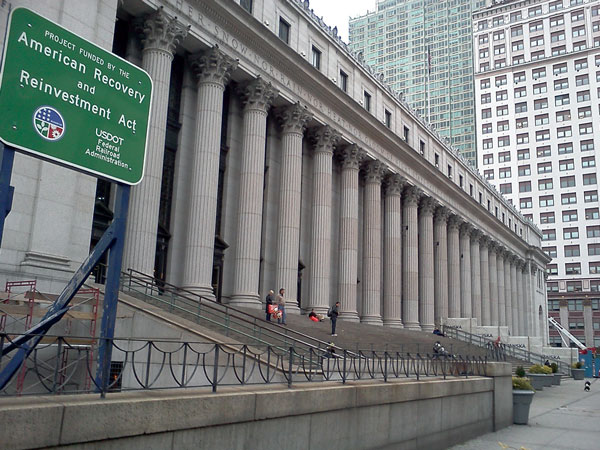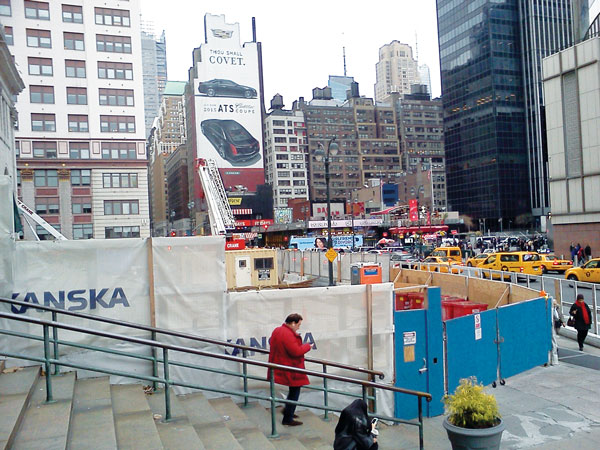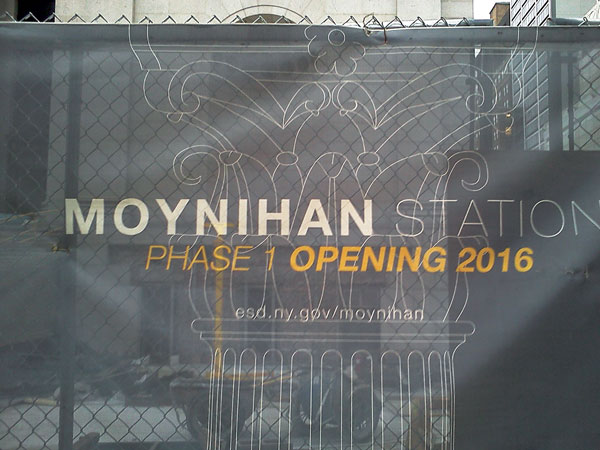
Several mesh signs on Eighth Ave. announce the completion date of Phase 1, and allow passersby a view of the construction.
BY RAANAN GEBERER | Take a walk past the James A. Farley Post Office on Eighth Ave., between 31st and 33rd Sts., and you’ll see evidence that — after years of planning — the Moynihan Station project is finally under way, and poised to give Penn Station a grand new entrance.
The northern half of the front steps have been cordoned off. Two cranes are positioned near the 33rd St. side. On the building’s northeastern side, a small staircase leading to the street has been removed. On several recent visits, cement was being poured for a street-level walkway that will lead to one of the new entrances and construction workers were operating jackhammers, Caterpillar vehicles and cranes. Along Eighth Ave., the mesh barriers display renderings showing what the building will look like when the project is finished (Phase 1 Opening 2016 | esd.ny.gov/moynihan), and white mesh barriers along the length of the steps announce that the work is being done by the huge construction firm, Skanska USA.
“We’re installing a new skeleton [below street level],” one worker told this reporter. “All new steel!”
After the venerable Penn Station building was razed in the 1960s and replaced with the current, humdrum underground terminal, preservationists periodically called for a more fitting station that would echo the grandeur of the original structure.
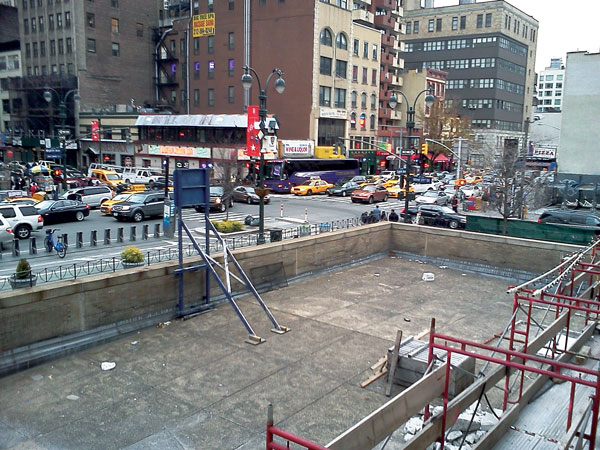
Below Photo: A sign links the Moynihan Station project to economic stimulus funds. Above photo: A view from the opposite side.
In the early 1990s, then-U.S. Senator Daniel Patrick Moynihan (D-N.Y.), who certainly remembered the fabled Penn Station of yesteryear, called for using part of the Farley Building, much of which is now empty, as a portal to the rail tracks. The Farley Building was designed by McKim, Mead and White, the same famous architectural firm that designed the original Penn Station across the street.
“The Farley Building is the twin of [the original] Penn Station, built a year after Penn Station by the same firm,” says Peg Breen, president of the New York Landmarks Conservancy, which has been involved in the project since it was first announced.
The plan is to use the huge, unused mail sorting room, behind the counters that postal customers see every day, into a new “train hall” with street-level entrances.
Amtrak — one of three entities that uses Penn Station (the others are NJTransit and the Long Island Rail Road) — will move its ticket counters, offices, baggage handling and waiting room there, along with direct access to platforms and retail amenities.
“This will take about 30 percent of the traffic out of [the current] Penn Station, and leave room to make improvements there,” says Breen. “Right now, Penn Station is so packed that you can’t do anything there.”
And that’s not all. “Moynihan Station is the future home of Amtrak’s operations,” says Craig Schulz, a spokesman for Amtrak. It fits, since, as Schultz says, Penn Station is “the busiest train station in the nation.”
The work that is going on now is part of Phase I of the project. According to Schulz and a spokesperson for the Empire State Development Corp. (ESDC), this includes:
• Expanding the terminal’s West End Concourse, which currently serves the Long Island Rail Road’s platforms (Platforms 7 to 11), to also connect to Platforms 3 to 10. It will “serve all Amtrak trains after 2016.”
• Expanding an existing underground corridor between the Farley Building and the existing Penn Station.
• Building new entrances into the West End Concourse through the 31st and 33rd St. corners of the Farley Building, as well as improvement of subway entrances to accommodate increased pedestrian traffic.
• Adding elevators to the concourse to make it ADA-compliant.
• Installation of an emergency ventilation system.
Several estimates of the cost for Phase 1 have been given — $300 million, $375 million — but it is clear that the majority of funding is from federal grants. “Contributions from the MTA and PA [Port Authority] capital plans comprise the balance of funding,” says the ESDC spokesperson.
While the project is being developed by the ESDC, its subsidiary, the Moynihan Station Development Corporation, and the Port Authority, other concerned organizations have contributed input. Among them are the Friends of Moynihan Station, the Municipal Art Society and the aforementioned Landmarks Conservancy.
As for day-to-day post office customer services, “half of the steps will be out of service for a period of two years — this is the only impact to USPS operations,” says the ESDC spokesperson.
Phase 2 will consist of the conversion of the old sorting room into the train hall, and is estimated to cost at least $1 billion. For the time being, according for the ESDC website, the room and another unused space, the postal dock, are available for events, filming, theater productions and the like.
Over the years, the Moynihan Station plan has gone through several twists and turns, including an effort to move Madison Square Garden (MSG) into more of the Farley Building’s unused space. “We opposed it when Madison Square Garden wanted to go in there years ago,” says Breen of the Landmarks Conservancy. “It would have overwhelmed the station.”
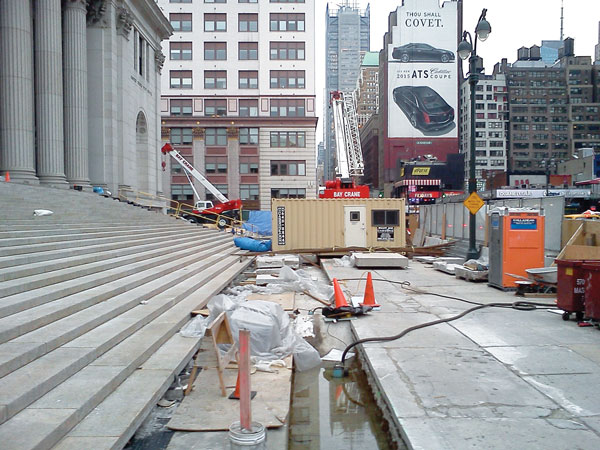
That doesn’t mean that MSG will be in its current space forever. The Landmarks Conservancy and the Municipal Art Society have launched a public campaign, called the “New Penn Station Alliance,” partially to “reconsider the location of Madison Square Garden atop our busiest and most vital transportation hub.”
The effort received a shot in the arm when, in July 2013, the City Council extended MSG’s special operating permit at its current site for a mere 10 years, not in perpetuity as the Garden had requested.
To many people, especially in the preservationist community, Moynihan Station is just the first step in restoring the glory that was once Penn Station. As Margaret Newman, executive director of the Municipal Art Society, told Chelsea Now, “MAS has long supported the Moynihan Station project, but it’s not the answer to our prayers as far as the transit emergency looming in Midtown West. It’s an important first step that will benefit Amtrak passengers, but it needs to be part of a larger package — namely, a new Penn Station.”



